Aerospace
The Brazilian armed forces acquire 27 H125 helicopters
It has acquired 27 single-engine H125 helicopters to boost the training capacity of the Brazilian Navy and the Air Force

Brasilia, The Brazilian armed forces, through the Combat Aircraft Programme Coordinating Committee (COPAC), has acquired 27 single-engine H125 helicopters to boost the training capacity of the Brazilian Navy and the Air Force.
The H125 will be produced in the H125 final assembly line located in Itajubá, Brazil at Helibras’ factory where the H225Ms for the Brazilian armed forces are also assembled. These new helicopters will replace the aging AS350 and Bell 206 helicopters currently in service with the Brazilian Air Force and the Brazilian Navy respectively.
“This joint procurement contract represents the realization of a project that will equip both the Brazilian Air Force and Navy with modern aircraft that will meet the needs of the Forces for the next 30 years,” said Commander of the Air Force, Lieutenant Brigadier Carlos de Almeida Baptista Junior.

“Airbus Helicopters is proud to see the H125 supporting the training of the next generation of pilots of the Brazilian armed forces. The H125 is a versatile helicopter used widely in both the civil and military markets as a training platform thanks to its ruggedness, reliability, and easy maintenance. We are honored by the continued confidence of the Brazilian armed forces after more than 40 years of cooperation,” said Bruno Even, CEO of Airbus Helicopters.
Aircraft comparison Brazil’s KC-390 vs Japan’s Kawasaki C-2(Opens in a new browser tab)
The new H125 helicopters will have a G500H TXi double glass cockpit and VEMD (Vehicle & Engine Multifunction Display) and will be compatible with the use of night vision goggles (NVG). They will also include different types of mission equipment such as a winch and a hook so that the training of future pilots is as representative of their missions as possible.
The Brazilian armed forces currently operate a total of 156 Airbus helicopters deployed from its eight bases across the country. Its fleet ranges from the light single engine Ecureuil family to the multi-purpose heavy H225M helicopter, 67 and 41 helicopters respectively, to cover a wide array of missions such as tactical transport, search and rescue missions, and civil population support.
10 things about Embraer KC 390.(Opens in a new browser tab)
The worldwide best-selling H125 has accumulated more than 37 million flight hours with more than 5350 helicopters currently in operation. The model, known for its robustness and versatility, is widely used in high-performance missions.
IAF to induct first batch of domestically built LCH at Jodhpur (Opens in a new browser tab)
#H125 @marmilbr @fab_oficial @AirbusHeli @helibras

Aerospace
Boeing Transfers Rocket Stage to NASA, Paving Way for Human Moon Mission

Boeing has achieved a significant milestone by providing NASA with the second core stage of the Space Launch System (SLS) rocket.
This crucial component, crafted at NASA’s Michoud Assembly Facility (MAF), is set to propel the Artemis II crew into lunar orbit, marking humanity’s return to deep space after a 50-year hiatus.
The monumental Boeing-built rocket stage, the largest element of the Artemis II mission, will embark on a journey aboard the Pegasus barge, traveling 900 miles to NASA’s Kennedy Space Center.
Comparison of two legendary aircraft B777x vs B747 aircraft:Click here
Upon arrival, it will be meticulously integrated with other essential Artemis II components, including the upper stage, solid rocket boosters, and NASA’s Orion spacecraft within the iconic Vehicle Assembly Building. This intricate integration process is a vital step toward the eagerly anticipated Artemis II launch, slated for 2025.
“Boeing-built products helped land humankind on the moon in 1969, and we’re proud to continue that legacy through the Artemis generation,” remarked Dave Dutcher, vice president and program manager for Boeing’s SLS program. “Together, with NASA and our industry partners and suppliers, we are building the world’s most capable rocket and paving the way to deep space through America’s rocket factory in New Orleans.”
NASA, Lockheed Martin Reveal X-59 Quiet Supersonic Aircraft:Click here
The delivery of Core Stage 2 marks a significant achievement in the evolution of the SLS rocket. Towering over 200 feet and powered by four RS-25 engines, this core stage, coupled with two solid-fueled booster rockets, will generate a staggering 8.8 million pounds of thrust. This immense power is crucial to launching Artemis II and future missions into the vast expanse of space.
The SLS rocket stands unparalleled in its capability to transport both crew and substantial cargo to the moon and beyond in a single launch. Its extraordinary capacity will facilitate the delivery of human-rated spacecraft, habitats, and scientific missions to destinations including the moon and Mars, ushering in a new era of space exploration.
-

 Travel1 week ago
Travel1 week agoAir India to Expand US Operations with Three New Routes After a Decade
-

 Travel2 weeks ago
Travel2 weeks agoWhy We Should Avoid These Stamps in a Passport
-

 Airlines1 month ago
Airlines1 month agoInvestigations Reveal Fake Chinese Titanium in Boeing and Airbus Jets
-

 Tech4 weeks ago
Tech4 weeks agoChina’s CATL Plans 1,800-Mile Electric Plane Launch by 2027
-

 Airport3 days ago
Airport3 days agoTop 10 Largest Airports in the World by Size
-

 Aerospace4 weeks ago
Aerospace4 weeks agoChina’s Fighter Jets Turn Wings into Autonomous Drones
-

 Airlines4 days ago
Airlines4 days agoAir India Rolls Out A350s for Delhi-New York JFK and Newark Routes
-

 Defence3 weeks ago
Defence3 weeks agoBoeing Enhances Chinook with New Engines and Block II Upgrades at $96 Million







